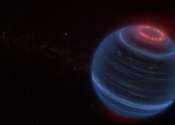James Webb Space Telescope data pinpoint possible aurorae on a cold brown dwarf
Using new observations from the James Webb Space Telescope (JWST), astronomers have discovered methane emission on a brown dwarf, an unexpected finding for such a cold and isolated world. Published in the journal Nature, ...









